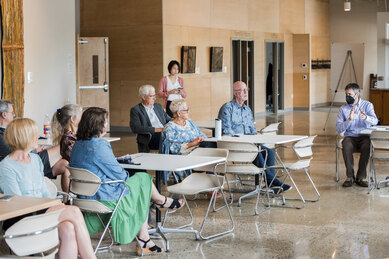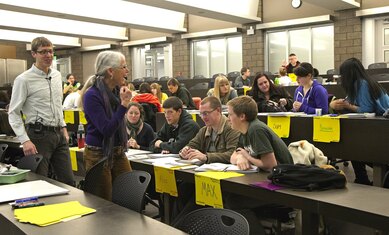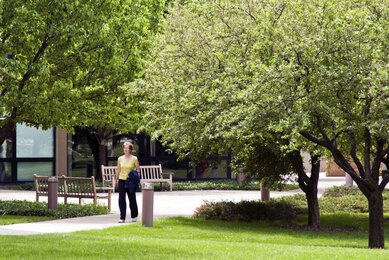Back to School: How University-based Retirement Communities are Redefining Senior Living
Over the next several years, the youngest members of the baby boom generation will reach the age of sixty-five, and more people will retire in the U.S. than ever before. With our increasing life expectancy, this generation of adults can be expected to remain active for 20 or 30 years after retirement. Baby boomers are also the most highly educated retirement demographic in history. They have higher expectations on all levels—physical, mental, and emotional—and are seeking retirement environments that will allow them to remain active, engaged, and connected to the world around them.
This desire to keep growing and learning has inspired many boomers to return to college, moving into the growing number of university-based retirement communities (URCs) nationwide.
Dating back to the mid-80s, URCs are a unique concept that has gained renewed momentum in the last 20 years. These communities, which now number nearly 100 in the U.S., offer a blend of the housing options, services, and security of a conventional senior living community and they do so amid a lively, multigenerational community dedicated to life-long learning. Living on or near campus, residents can enroll in and audit college courses, use school amenities like libraries, gyms, and museums, and participate in school activities and events.
Life at a URC has many benefits. Mastering new skills builds confidence and resilience, while shared classroom projects foster meaningful engagement and combat loneliness, a significant risk for adults. URC residents enjoy a lively, walkable campus with varied activities, including sporting events, theater, and concerts, allowing them to connect with people of all ages and share their perspectives and experiences. Adults can also benefit from student assistance with physical tasks, errands, or technology.
Each URC offers unique experiences, integrating adults with university life through thoughtful programs to bring generations together. This ranges from Mirabella at Arizona State University hiring a Director of Lifelong University Engagement to The Woodlands at Furman offering an Adopt-a-Grandparent/Adopt-a-Grandchild program. Many URCs also feature community gardens tended by members of all ages, fostering a sense of community and collaboration.
Most URCs offer a range of housing options, from apartments to cottages, villas, townhomes, and single-family homes. Like the first of their kind—Green Hills at Iowa State University and Meadowood at Indiana University—most of these communities utilize the Life Plan Community model, offering a full continuum of care options, including independent living, assisted living, memory care, and skilled nursing. Several communities also provide palliative and respite care. Some, like the Kendal properties in Ithaca, NY and Hanover, NH, have comprehensive healthcare services onsite, with a hospital on campus or nearby.
Most URCs are located directly on the college campus to facilitate deep integration, while others are nearby. At the extreme, Sweetwood of Williamstown (independent living apartments only) is four miles from the Williams College campus, with additional affiliations with Berkshire Community College and Mount Greylock regional (K-12) school.
Residents of URCs are offered a variety of learning experiences, ranging from auditing regular college courses to participating in classes designed specifically for older learners, with some residents even teaching courses or skills. Lasell Village of Lasell College in Massachusetts is one of the few communities with learning requirements. All residents are required to spend at least 450 hours learning or being active; this includes classroom instruction and recreational activity. This commitment to learning is backed by the university retirement community having its own dean, library, and gym just for the residents. Kendal-Crosslands Community in Pennsylvania encourages lifelong learning for its residents with an auditorium for lectures and presentations and partnerships with two nearby universities and a night school.
At some URCs, adults can participate in medical research or practicums and receive conventional, alternative, or experimental treatments, while students receive real-world experience in nursing, PT, medicine or research. The Knolls of Oxford, affiliated with Miami University in Ohio, houses the Scripps Gerontology Center, where adults can participate in research studies related to aging. In Maine, the Wardell Retirement Community allows adults to volunteer in the Geriatrics Practicum, which offers experiential learning opportunities to medical students at the University of New England.
The first university retirement community in the state of Maryland is being developed through a partnership between Goucher College and Edenwald Senior Living. Goucher is one of only two colleges in America that require students to study abroad, and it will leverage its expertise in global education to offer intensive, intergenerational study courses abroad for Edenwald residents and students. Goucher is also developing new intergenerational classes, spanning a range of topics and disciplines, that will be integrated into the undergraduate curriculum.
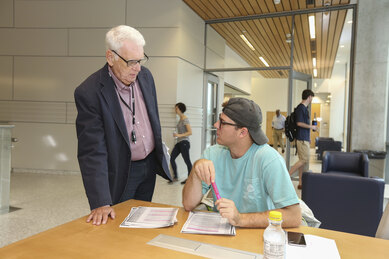
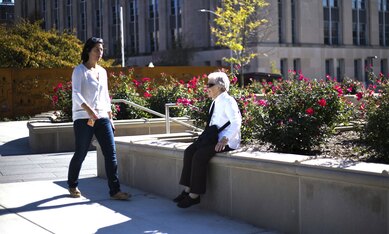
University retirement communities offer life-long learning, connections with people of many ages, and a sense of possibility as an antidote to one of the most pressing challenges facing adults today: isolation and disconnection from society. Colleges and universities have their own imminent challenge as the traditional college-age population in the U.S. is expected to shrink dramatically for at least a decade. By addressing the needs of both adults and educational institutions, URCs create a mutually beneficial solution that enriches lives and strengthens communities for all generations.
